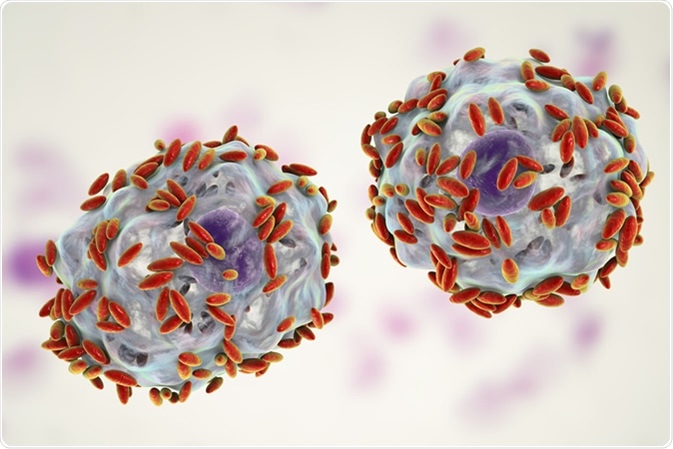Skip to:
What are Bacteria?
Bacteria are single-cell microorganisms that have walls but no organelles or stable nucleus. Some bacteria can cause disease and infection in humans. There are also good bacteria present in the human body that help in vitamin synthesis and digestion in the gut or prevent overgrowth of other microorganisms in various areas of the body.

Legionella pneumophila - medical 3d illustration. Image Credit: peterschreiber.media / Shutterstock
Which bacterial infections are dangerous in pregnancy?
There are, however, some bacteria that are more dangerous during pregnancy because they can affect both the mother and the unborn baby in many adverse ways. Some bacteria are more common in pregnant women, and precautions must be taken to ensure a smooth pregnancy.
Unborn babies and pregnant women have weaker immune systems, and it becomes more difficult to fight off certain types of infection
Bacterial Vaginosis
Bacterial vaginosis is a common infection of the reproductive tract in women, and it can cause worse symptoms in pregnant women. Symptoms include itchiness, tick, white, cottage cheese-like vaginal discharge, pain around the vaginal area, and odor. Bacterial vaginosis is caused by an increased build-up of bacteria in the vagina.

Microscopic diagnosis of bacterial vaginosis. Vaginal secretions contain epithelial cells, so-called clue cells covered with bacteria Gardnerella vaginalis, 3D illustration Credit: Kateryna Kon / Shutterstock
BV can be dangerous when left untreated. The infection infects the fallopian tubes and can affect the uterus. Side effects such as premature birth and fetal membranes can be damaged, causing premature rupture and infection. Premature birth can be associated with low birth weight and other health problems.
Group B Streptococcus
Another common bacterium is Group B Streptococcus (GBS), a type of bacteria that is common in the vagina; these bacteria come and go; however, they are more common and have increased risk during pregnancy.
GBS is the most common life-threatening infection in pregnant mothers and babies. In newborn babies, this bacterium can cause meningitis, a potentially fatal inflammation of the tissue surrounding the brain.
During pregnancy, a mother will not know if they have this infection, it is discovered once a mother is tested for colonization. As there are no side effects, the condition may be missed if the mother is not tested. It is uncommon for the unborn baby to acquire the infection in the womb. It isn't until the baby is born that they are at risk of acquiring GBS.
On average, 15% to 20% of women carry Group B Streptococcus, and half of the unborn babies become exposed to the bacteria during labor if the mother has not been treated. If a baby acquires the infection, they are more susceptible to develop sepsis (blood infection) and meningitis six to twelve hours after birth.
The infection is found in healthy women; in the US, 1 in 2,000 babies have been infected. To prevent poor outcomes associated with GBS, women are regularly screened for GBS in the third trimester of pregnancy so that antibiotics can be given during labor to try and reduce the risk of it passing onto the unborn baby.
Urinary Tract Infections
Urinary Tract Infections are known more informally as UTIs are common amongst all women. UTIs occur when bacteria, usually from the gastrointestinal tract, infect one or more portions of the urinary tract.
The aftereffects of UTIs can have severe effects on the kidneys. Some symptoms of UTIs affecting the kidneys are chills, fever, and pain in the back, side, and abdomen. A kidney infection is medically known as Pyelonephritis, and in pregnancy, this can lead to premature labor and low birth weight in the baby.
UTIs also can affect labor, making it more difficult and possibly more dangerous; there have been some cases in which individuals have experienced list-threatening complications.
Treatments for UTIs include antibiotics and, in some circumstances, may require hospitalization in pregnant women as there are serious side effects.
The monitoring of the fetus is essential if the mother develops a fever during labor. In some cases, if the symptoms are severe, then it may be necessary for cesarean delivery.
Precautions to consider
Most bacteria are not dangerous during pregnancy and don't have any severe side effects on babies. If bacterial infections are discovered early and treated effectively, they are more likely to have healthy babies and healthy births.
It is essential for pregnant women to have prenatal care and to consult a doctor or nurse when any symptoms may be present while pregnant to protect both themselves and baby.
- Prevention of group B streptococcal early-onset disease in newborns. (2019).
acog.org/Clinical-Guidance-and-Publications/Committee-Opinions/Committee-on-Obstetric-Practice/Prevention-of-Group-B-Streptococcal-Early-Onset-Disease-in-Newborns
- Baker, C. (1997) "Group B Streptococcal Infections", Clinics in Perinatology, 24(1), pp. 59-70. doi: 10.1016/s0095-5108(18)30184-2.
- Group B Strep Infection: GBS - American Pregnancy Association (2012). Available at: https://americanpregnancy.org/pregnancy-complications/group-b-strep-infection (Accessed: 20 February 2020).
- AboutKidsHealth (2020). Available at: https://www.aboutkidshealth.ca/Article?contentid=352&language=English (Accessed: 20 February 2020).
- Aguin, T. and Sobel, J. (2015) "Vulvovaginal Candidiasis in Pregnancy", Current Infectious Disease Reports, 17(6). doi: 10.1007/s11908-015-0462-0. https://link.springer.com/article/10.1007/s11908-015-0462-0
- Baud, D. and Greub, G., 2011. Intracellular bacteria and adverse pregnancy outcomes. Clinical Microbiology and Infection, 17(9), pp.1312-1322. https://pubmed.ncbi.nlm.nih.gov/21884294/
- Bacterial Infections and Pregnancy: Practice Essentials, Overview, Group B Streptococcus (2020). Available at: https://emedicine.medscape.com/article/235054-overview (Accessed: 20 February 2020).
- Bacterial vaginosis and pregnancy (2020). Available at: https://www.marchofdimes.org/complications/bacterial-vaginosis.aspx (Accessed: 20 February 2020).
Further Reading